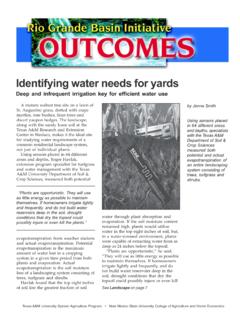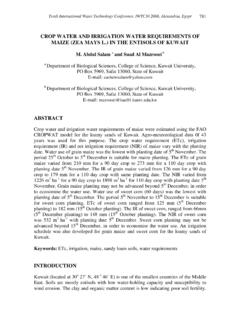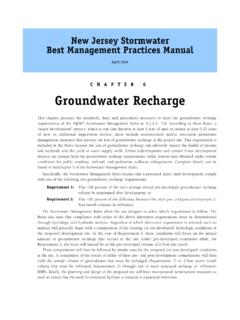Transcription of NOAA Technical Report NWS 34 - DYNSYSTEM
1 noaa Technical Report NWS 34 Mean Monthly, Seasonal, and Annual Pan evaporation for the United States Richard K. Farnsworth and Edwin S. Thompson Office of Hydrology National Weather Service Washington, December 1982 LIBRARY .. A. Qe ~ I ,U~~ no. 3+ [lqb4-19f2] U S Dept of Commerce DEPARTMENT OF COMMERCE Malcolm Baldrige, Secretary National Oceanic and Atmospheric Administration John V. Byrne, Administrator National Weather Service RIchard E. Hallgren, Acting Assistant Administrator National Oceanic and Atmospheric Administration Climate Database Modernization Program ERRATA NOTICE One or more conditions of the original document may affect the quality of the image, such as: Discolored pages Faded or light ink Binding intrudes into the text This document has been imaged through the noaa Climate Database Modernization Program.
2 To view the original document, please contact the noaa Central Library in Silver Spring, MD at (301) 713-2607 x124 or LASON Imaging Subcontractor 12200 Kiln Court Beltsville, MD 20704-1387 March 28, 2002 CONTENTS 'N' .. 1 MEAN MONTHLY, SEASONAL, AND ANNUAL CLASS A PAN evaporation COMPILATION (TABLE I) .. 7 MEAN MONTHLY, SEASONAL, AND ANNUAL PAN evaporation COMPUTED BY METEOROLOGICAL FACTORS (TABLE 11) 62 ACKNOWLED(;MENTS 82 RE FE RE NeE S .. 82 APPENDIX A .. 4-1 FIGURES 1. Distribution of Class A pan stations reporting observed evaporation only .. " .. 4 2. Distribution of Class A pan stations reporting observed evaporation and maximum and minimum water temperature 5 .3. Distribution of weather stations at which evaporation can be estimated by the Penman equation 6 AI.)
3 Monthly distribution at Vaughn, New Mexico based on evaporation distribution at Alamogordo Dam and Santa Fe A-3 TABLES AI. Monthly fractions of annual and seasonal evaporation at Alamogordo Dam and Santa Fe . A-2 A2. Monthly potential evaporation (FWS), in inches, at Vaughn, New Mexico , A-2 iit MEAN MONTHLY, SEASONAL, AND ANNUAL PAN evaporation FOR THE UNITED STATES Richard K. Farnsworth and Edwin S. Thompson Hydrologic Research Laboratory National Weather Service. noaa Silver Spring, Maryland INTRODUCTION This publication is a compilation of monthly, seasonal, and annual averages of estimated pan evaporation based on observations from Class A pans and on meteoro-logical measurements by the National Weather Service (NWS) and cooperating agencies.
4 It replaces Technical Paper No. 13 ( Weather Bureau, Hydrologic Branch, Division of Climatological and Hydrologic Services, 1950). These tabulations were generated from the augmentation of a smaller data set used to develop evaporation maps published in noaa Technical Report NWS-33, evaporation Atlas for the Contiguous 48 United States, (Farnsworth et al., 1982). This Report and its companion Report , the evaporation atlas, should facilitate the determination of monthly values of evaporation at most points in the country. The data set used for the evaporation atlas included, at most, 15 years of data record. To obtain the tabulations contained in this Report , the data set was enlarged to include the available period of record (through January 1981 for currently active stations). Therefore, while this Report was produced at the same time as the evaporation atlas, there are some significant differences in the data used.
5 The data sets used to produce the maps in the evaporation atlas were selected and, in some cases. adjusted to fit a common base period of 1956-70. For this Report . the total period of record rather than a common time base was chosen for the record of observed pan evaporation . This avoids possible errors which might result from adjustments made to fit the common time base. Inclusion of the additional data periods of observed pan records required only tabulation from published records. However. the estimation of "pan" evaporation based on meteorological measurements requires many computations. and so only estimates for years for which the data were already prepared for computer processing (1956-70) for the atlas were included in this Report . For the same reason, coefficients of variation of the monthly. seasonal, and annual values of the pan data were computed only for the 1956-70 base except for stations in the state of California which were available on magnetic tape for their full periods of record.
6 evaporation means are included for only those stations that have at least 1 month with a period of record of 10 years or more prior to January 1981. evaporation means for months with less than 5 years of record are omitted. Those means for months with between 5 and 10 years of record are shown to the nearest inch. This format should remind the user that these data cannot be treated with the same confidence as those means with 10 years or more of record which are shown to the nearest inch. Actually. the latter should not be interpreted to an accuracy greater than inches. Ho~ever. the additional decimal place was retained to conform with published records. 1 Months with fewer than 20 observations were excluded from the analysis. This occurred mainly where observations were not taken on weekends, observers went on vacation, or temperatures were near or below freezing.
7 The data are presented in two tables. Table I lists averages based on observed Class A pan data, ano. table II lists average "pan" evaporation based on estimates of monthly evaporation derived from hydrometeorological measurements using a form of the Penman equation described by Kohler et ale (1955). Individual stations listed in the tables are ordered alphabetically within their appropriate states. The states are also listed alphabetically. Table I data are generated primarily from data published in the series, Climatological Data of the United States ( noaa -EDIS). Details on site operation, including the name of the individual or agency operating the station, can be found in the annual summaries. Measurements obtained using non-standard pans, installations, or methods are difficult to compare with those obtained using the standard pans and, therefore, have more limited use.
8 Only stations using standard Class A pans, with a standard installation, and assumed to be following standard procedures are included in table I. The standard Class A pans are unpainted, constructed of monel or galvanized metal, inches in diameter, 10 inches deep, and mounted on a platform which raises the pan base a few inches above the surrounding ground. The installation of the pan and the measurement procedures are described in the NWS Observing Manual No. 2--Substation Observa-tions ( noaa -NWS 1972). Approximate locations of the pans are shown in figures 1 lind 2. Figure 1 shows those stations which observe only the evaporation from the pan while figure 2 shows stations measuring, in addition to evaporation , the temperature of the water in the pan and the total wind movement over the pan. The values in table II are estimates based on hydrometeorological data for stations, most of which are published in the series Local Climatological Data ( noaa -EDIS).
9 Details regarding individual stations are found in this publica-tion, especially the issues which present annual summaries. As indicated previ-ous ly, these data are averages of es timates of monthly Class A "pan" evaporation derived from hydrometeorological measurements. These measurements were taken at the stations of the NWS basic and synoptic network ( noaa -NWS 1979) which had at least 1 month with 10 years of record during the evaporation atlas base period, 1956-70. The locations of these stations are identified in figure 3. The obser-vations required for the evaporation estimates were mean air temperature, mean dew point, the total wind movement 2 feet above the ground surface, and an esti-mate of incoming solar radiation. Daily wind movement was generally estimated from available wind speeds observed every six hours at the station anemometer height (often around 20 feet).
10 This estimated wind movement was then adjusted, using a logarithmic relationship, to obtain an equivalent Wind movement at 2 feet. Solar radiation was either measured directly (at those stations equipped with pyranometers), estimated from hours of sunshine (at stations equipped With sunshine recorders) (Hamon et al., 1954), or estimated from cloud cover (at the remainder of the stations) (Thompson, 1976). The monthly mean estimated pan evaporation was computed for each month using eq. 1 of noaa Technical Report NWS-33. A period-of-record average for each month of the year was formed by taking the average of all the values for a given month included in the period of record. The individual monthly Sums were formed by multiplying the daily average by the number of days in the month. The data used to estimate each daily mean consisted of the mean daily air and dewpoint temperature and mean daily accumulations of solar radiation (sometimes estimated 2 from sky cover) and wind travel for the month.





